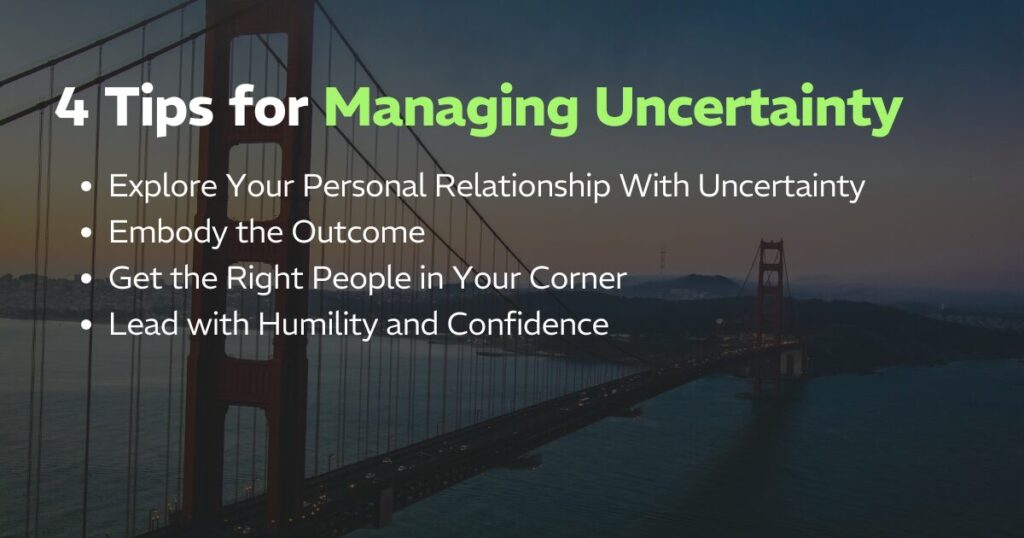Leading through uncertainty is one of the hardest parts of leadership — and one of the most important.
It’s also personal. Uncertainty hits each of us differently. Sometimes it creeps in slowly. Sometimes it crashes through the door. Either way, it challenges your clarity, tests your confidence, and invites you to step forward without a guarantee.
I’ve learned that uncertainty is more than a passing phase. It’s a constant, especially in leadership. The key isn’t to avoid it. It’s to learn how to navigate it.
When Uncertainty Becomes the New Normal
Navigating uncertainty is necessary for leading a team, growing a business and enjoying a fulfilling, meaningful and abundant life. It’s also where we grow our own resilience and the confidence that we can recover well from the inevitable setbacks that are part of any grand adventure..
In May 2024, the National Federation of Independent Business (NFIB) Uncertainty Index reached its highest levels since November 2020. We can all remember how “unprecedented” 2020 was, and yet many of us are still facing increasing uncertainty, change and disruption due to factors like inflation, labor shortages, and lower sales and inventory.
Uncertainty is the new normal, and knowing how to leverage uncertainty into opportunity is a real advantage. Here’s how to do exactly that.

Explore Your Personal Relationship With Uncertainty
Everyone has a different relationship with uncertainty. Some people crave stability — which makes sense. But that’s rarely the path of a leader, entrepreneur, or changemaker.
Where do you fall on that spectrum? And how is that relationship serving you right now?
I was coached to consider the worst case scenario when making a tough decision. And while there’s value in facing reality and preparing for risk, I found that this kind of thinking often led me to hesitation. What’s the worst that could happen?
That mindset doesn’t create momentum. It creates paralysis.
Understanding your own default response to coping with uncertainty is a key part of managing that uncertainty.
Embody the Outcome
When things feel uncertain, it’s easy to go straight to worst-case thinking and other negative thoughts. Feeling anxious in uncertain times is human. But if we stay in that space long term, we can lose the very mindset we need to move forward.
Try asking yourself a different question: What’s the absolute best that could happen?
You don’t need to know exactly how things will unfold. You just need to begin to embody the feeling of the experience or outcome you want to achieve.
For me, that shift invites visioning the future. It pulls me forward into creativity and belief. It reminds me that I get to choose what I believe — and that belief shapes how I show up, especially in uncertain moments.
What does it look like for you to show up as if the result you want is already happening? What would change in your energy, your choices, your communication? That shift — even a subtle one — can have a ripple effect. Especially when you’re leading through change and uncertainty.
Get the Right People in Your Corner
I’ve been lucky. I have incredible relationships in my life — family, friends, business partners, colleagues, a coach, and what I call my Personal Board of Directors
Spending time with these people helps me stay grounded. They remind me of who I am. They give me perspective, encouragement, and challenge — especially when I need it most. From my experience, it’s much easier to navigate times of uncertainty when you’re not in it alone.
You need people in your corner who support you. It’s not a weakness to ask for help during difficult times. It’s smart leadership.
What are you struggling with right now? Where could you use help? Answer these questions honestly and with curiosity. Just because you’re a leader doesn’t mean you can’t ask for help. In fact, I’d suggest that it’s often the leader or entrepreneur that needs support — we really are better together!
Lead with Humility and Confidence
Leading through ambiguity often means making decisions without all the data. There’s pressure to project certainty — even when you don’t feel it.
But the best leaders I’ve worked with — and learned from — know how to hold both humility and confidence at the same time. They trust their instincts, and they stay open to learning. They move forward, and they make room to adjust.
You don’t need perfection. You need presence. You don’t need to know exactly what’s next. You need to stay aligned with your values as you move through your decision making process
This is the kind of leadership the world needs now. It’s also what I explore more deeply in my keynote on Human-Centered Leadership — how to lead with empathy, clarity, and trust when people need it most.



![[RYAN] Featured_Leadership Development Planning for Human Centered Growth Group climbing a hill together](https://ryanestis.com/wp-content/uploads/bb-plugin/cache/RYAN-Featured_Leadership-Development-Planning-for-Human-Centered-Growth-1024x538-panorama-ba61edeb5d6c961b544c5c7916ed5ca0-.png)






